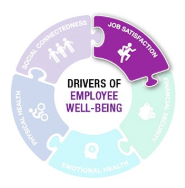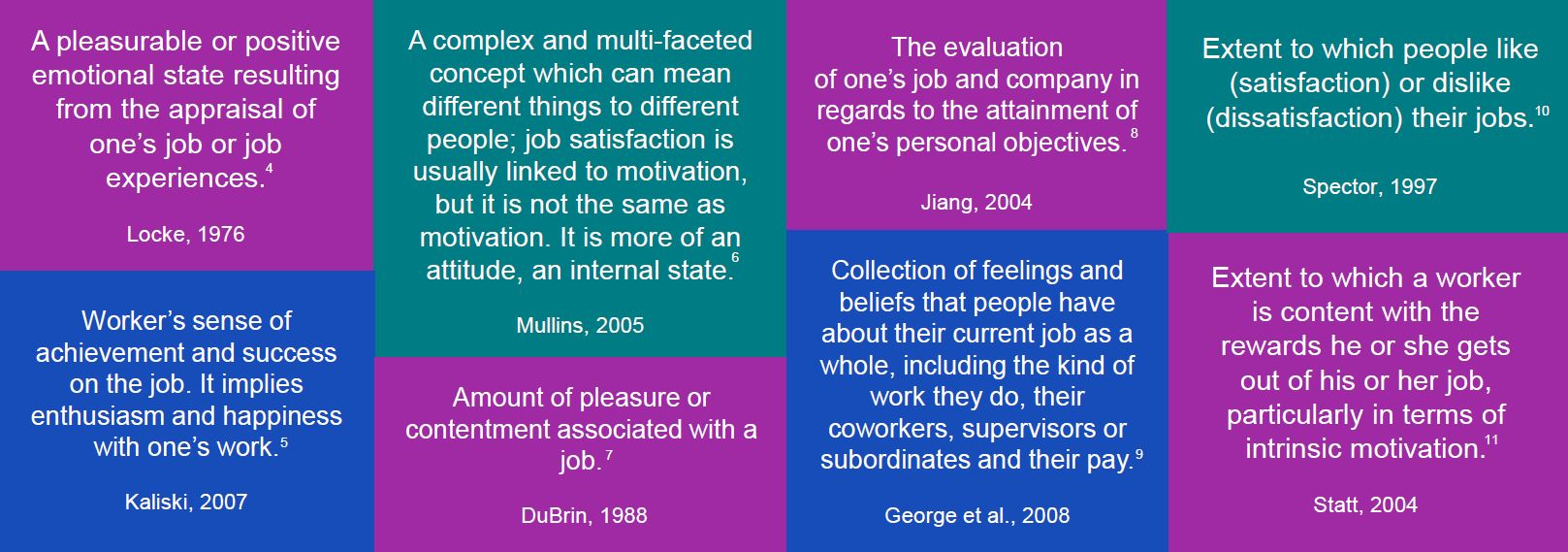January 09, 2020
The Job Satisfaction: The Secret Agent of Well-being article can help businesses re-examine organizational practices and policies that influence job satisfaction and overall well-being. The right approach to engaging the workforce will vary by employer, and moreover by local teams. Having conversations within organizations about the content shared here can illuminate workforce-specific challenges and solutions.
This resource is intended for HR/Benefits practitioners, managers, executives and employees, because individuals at all levels can be champions for change and play an important role in shaping the workplace culture. Organizations don’t change, people do!

Introduction to Job Satisfaction

Evidence shows that job satisfaction is integral to one’s overall well-being. According to Gallup, people with high career well-being are more than twice as likely to have high overall well-being.
Job satisfaction impacts and is impacted by the other four dimensions of well-being: social connectedness, physical heath, emotional heath and financial security.
A systematic review of the link between job satisfaction and health found it was most strongly associated with mental health, such as depression, anxiety, burnout, self-esteem and sleep problems.
Study Finds Job Dissatisfaction has Negative Impact on Health by Age 40
Dirlam and Zheng investigated the relationship between job satisfaction and health using a life-course approach. They found job satisfaction, or lack of it, between ages 25-29 has a cumulative effect on health as early as age 40. Those with the lowest job satisfaction had the worst health. However, individuals who started their career with low job satisfaction and trended up did not experience the health problems associated with consistently low or declining job satisfaction. Furthermore, job satisfaction affected mental health more than physical health.
What is Job Satisfaction?
While job satisfaction is discussed on a regular basis, there is not one definition for the concept. Here are some popular ways to define job satisfaction from the research literature:

Job Satisfaction and Employee Engagement
Contributors to job satisfaction are often linked to employee engagement. They influence capacity of employees and reasons to engage. Most likely, an engaged employee is also satisfied. However, a satisfied employee may have low engagement. The workforce approach to address both is to create an experience that allows employees to thrive.
Job satisfaction refers to how employees feel about their job and other conditions, such as compensation, benefits, relationships, flexibilities and developmental opportunities
Employee engagement refers to employees’ passion and commitment in their work, their overall attachment to the organization and the discretionary effort they are willing to expend
Employee Satisfaction may Increase Business-Unit Outcomes, Including Profit
A meta-analysis based on 7,939 business units in 36 companies found both employee satisfaction and engagement are correlated to meaningful business outcomes. The Gallup Workplace Audit which includes an overall satisfaction item and a 12 item engagement index was used. The strongest effects were found with employee turnover, customer satisfaction-loyalty and safety. Correlations were positive and generalizable for productivity and profitability but at a lower magnitude.
Job Satisfaction and Its Connection to Other Components of Well-being
- Perceptions of pay fairness are positively correlated with employee engagement and work-life satisfaction, and negatively correlated with turnover intentions and work stress. Furthermore, job security (specifically the prospect of job and salary loss) has a strong correlation with job satisfaction.
- Job satisfaction is more strongly associated with mental/psychological problems than with physical complaints.
- Work friendships boost employee satisfaction by 50%, and employees with a best friend at work are seven times more likely to fully engage.
- Amount of pleasure or contentment associated with a job. DuBrin, 1988
- Job satisfaction is correlated positively with mental health characteristics, such as depression, anxiety, self-esteem and general mental health. The correlation with physical health was more modest.
- Psychological well-being moderates the relation between job satisfaction and performance. Performance is highest when employees report both high psychological well-being and job satisfaction.
- Insomnia is associated with reduced job satisfaction.
Strategic Partners for Job Satisfaction
Engagement of multiple stakeholders can increase access to resources and enable successful transformation. Find ways to add value to potential partners and build strategic relationships that can be leveraged to integrate drivers of job satisfaction and strategies for overall well-being throughout the organization. Here are some possible allies:
- Well-being and Benefits Professionals
- Learning & Development Practitioners
- EAP Counselors
- Diversity and Inclusion Specialists
- Health Coaches
- Wellness Champions
- Corporate Social Responsibility Teams
- Employee Affinity Groups
- Senior Leaders
- Managers
- Team Leads
- Unions
- Facility Managers
- OHS Practitioners
- Other HR Teams
More Topics
Articles & Guides- 1 | Rath T, Harter JK. Wellbeing: The five essential elements. NY: Gallup Press; 2010.
- 2 | Faragher EB, Cass M, Cooper CL. The relationship between job satisfaction and health: a meta-analysis. Occupational and Environmental Medicine. 2005; 62:105-112.
- 3 | Dirlam J, Zheng, H. Job satisfaction developmental trajectories and health: A life course perspective. Social Science & Medicine. 2017; 178: 95-103.
- 4 | Locke, EA. The nature and causes of job satisfaction. In M.D. Dunnette (Ed.), Handbook of industrial and organizational psychology. Chicago: Rand McNally; 1976.
- 5 | Kaliski, BS. Encyclopedia of Business and Finance, second edition. Detroit: Thompson Gale; 2007.
- 6 | Mullins, JL. Management and organizational behavior, seventh edition. Essex: Pearson Education Limited; 2005.
- 7 | DuBrin, AJ. Human relations: A job oriented approach, fourth edition. Prentice-Hall; 1988.
- 8 | Jiang N. Measurement of job satisfaction reconsidered: A structural equation modeling perspective. Paper presented at the annual meeting of the American Sociological Association, Hilton San Francisco & Renaissance Parc 55 Hotel, San Francisco, CA; Aug 14, 2004.
- 9 | George JM, Jones GR. Understanding and managing organizational behavior, fifth edition. New Jersey: Pearson/Prentice Hall; 78; 2008.
- 10 | Spector PE. Job satisfaction: Application, assessment, causes, and consequences. Thousand Oaks, CA: Sage; 1997.
- 11 | Statt D. The routledge dictionary of business management, third edition. Detroit: Routledge Publishing; 78; 2004.
- 12 | Bersin J. It’s time to rethink the ‘employee engagement’ issue. Forbes. 2014. https://www.forbes.com/sites/joshbersin/2014/04/10/its-time-to-rethink-the-employee-engagement-issue/#d0313e26cf36. Retrieved October 18, 2017.
- 13| Harter JK, Schmidt, FL, Hayes TL. Business-unit-level relationship between employee satisfaction, employee engagement, and business outcomes: A meta-analysis. Journal of Applied Psychology. 87(2), 268-279; 2002.
- 14 | Szypko, MA. Pay fairness and its impact on employee engagement. IBM WorkTrends 2013 U.S. only. http://rewardspnw.com/program/presentations/MarkSzypko.pdf. Retrieved January 16, 2018.
- 15 | NEF Consulting. Well-being at work: A review of the literature. http://neweconomics.org/2014/03/wellbeing-at-work/?lost=true&_sf_s=+publications+++well+being+at+work. 2014. Retrieved January 16, 2018.
- 16 | Faragher EB, Cass M, Cooper CL The relationship between job satisfaction and health: a meta-analysis. Occupational and Environmental Medicine 62. 105-112; 2005.
- 17 | Gallup. State of the American Workplace report. 2012.
- 18 | Wright TA, Cropanzano R, Bonett D. The moderating role of employee well being on the relationship between job satisfaction and job performance. Journal of Occupational Health Psychology. 12(2); 93-104; 2007.
- 19 | Scott, BA, Judge, TA. Insomnia, emotions, and job satisfaction: A multilevel study. Journal of Management. 32(5); 622-645; 2006.
- 20 | Society for Human Resource Management. Employee job satisfaction and engagement: The doors of opportunity are open. https://www.shrm.org/hr-today/trends-and-forecasting/research-and-surveys/Documents/2017-Employee-Job-Satisfaction-and-Engagement-Executive-Summary.pdf. 2017. Retrieved October 18, 2017.
- 21 | Maslow A. A theory of human motivation. Psychological Review. 50(4), 370-396; 1943.
- 22 | Herzberg F, Mausner B., Snyderman, BB. The motivation to work. John Wiley & Sons, Inc. 1959.
- 23 | McClelland, DC. The achieving society. New York, NY: The Free Press; 1961.
- 24 | Hackman JR, Oldham, GR. The job diagnostic survey: An instrument for the diagnosis of jobs and the evaluation of job redesign projects. Department of Administrative Sciences: Yale University. 1974.
- 25 | Berg JM, Dutton, JE, Wrzesniewski A. What is job crafting and why does it matter? Center for Positive Organizational Scholarship: Michigan Ross School of Business. 2008.
- 26 | McGregor D. The human side of enterprise. McGraw-Hill. 1960.
- 27 | Adams, JS. Toward an understanding of inequity. Journal of Abnormal and Social Psychology. 67, 422-436; 1963.
- 28 | Alderfer, CP. Organizational behavior and human performance. 4(2), 142-175; 1969.
- 29 | Harter JH, Asplund JW, Fleming JH. HumanSigma: A meta-analysis. Gallup Management Journal. 2004.
- 30 | Pink, DH. Drive: The surprising truth about what motivates us. Riverhead Books. 2011.
- 31 | Deniz, N, Noyan A, Ertosun O. Linking person-job fit to job stress: The mediating effect of perceived person-organization fit. Procedia-Social and Behavioral Sciences. 207(20), 369-376; October 2015.
- 32 | Anchor, S. The happiness advantage. New York, NY: Crown Publishing Group. 2010.
- 33 | Berkman, L. F., Buxton, O., Ertel, K., & Okechukwu, C. Managers' practices related to work-family balance predict employee cardiovascular risk and sleep duration in extended care settings. Journal of Occupational Health Psychology. 15(3), 316-329; 2010.
- 34 | Grzywacz, J. G., Carlson, D. S., & Shulkin, S. Schedule flexibility and stress: Linking formal flexible arrangements and perceived flexibility to employee health. Community, Work & Family. 11(2), 199-214; 2008.
- 35 | Moen, P., Kelly, EL, Tranby, E., Qinlei H. Changing work, changing health: Can real work-time flexibility promote health behaviors and well-being? Journal of Health and Social Behavior. 52(4), 404-429; 2011.
- 36 | Aon Hewitt. Trends in global employee engagement. http://www.aon.com/attachments/ thought-leadership/Trends_Global_Employee_Engagement_Final.pdf. 2011. Retrieved October 12, 2017.
- 37 | Buckingham M. Let’s fight the right talent war. https://www.marcusbuckingham.com/rwtb/lets-fight-the-right-talent-war/. 2017. Retrieved November 1, 2017.
- 38 | American Psychological Association. Employee recognition survey. http://www.apaexcellence.org/assets/general/employee-recognition-survey-results.pdf. 2014. Retrieved October 17, 2017.
- 39 | Morgeson, FP. Humphrey, SE. The work design questionnaire (WDQ): Developing and validating a comprehensive measure for assessing job design and the nature of work. Journal of Applied Psychology. 91(6), 1232-1339; November 2006.
- 40 | Chaboyer W, Williams G, Corkill W, Creamer J. Predictors of job satisfaction in remote hospital nursing. Canadian Journal of Nursing Leadership. 12(2):30-40; 1999.
- 41 | Warr P. Work, happiness and unhappiness. London: Lawrence Erlbaum Associates; 2007.
- 42 | Kjerulf A. The chief happiness officer blog. 2017. https://positivesharing.com/; Retrieved December 1, 2017.
This content is for members only. Already a member?
Login
![]()
